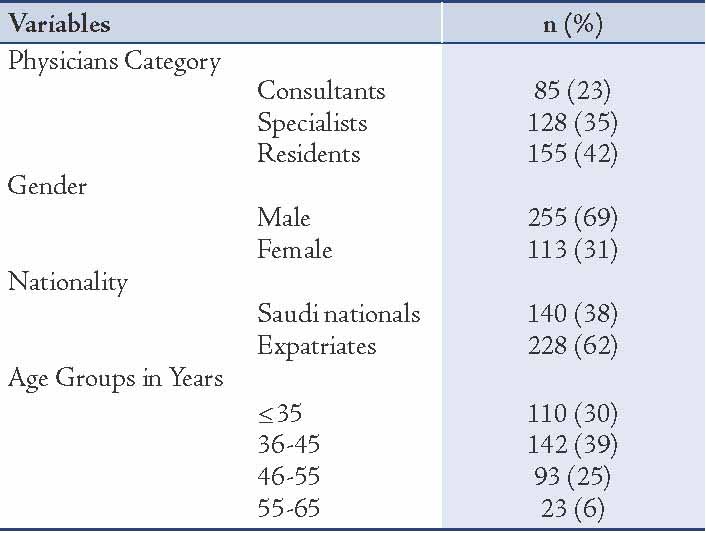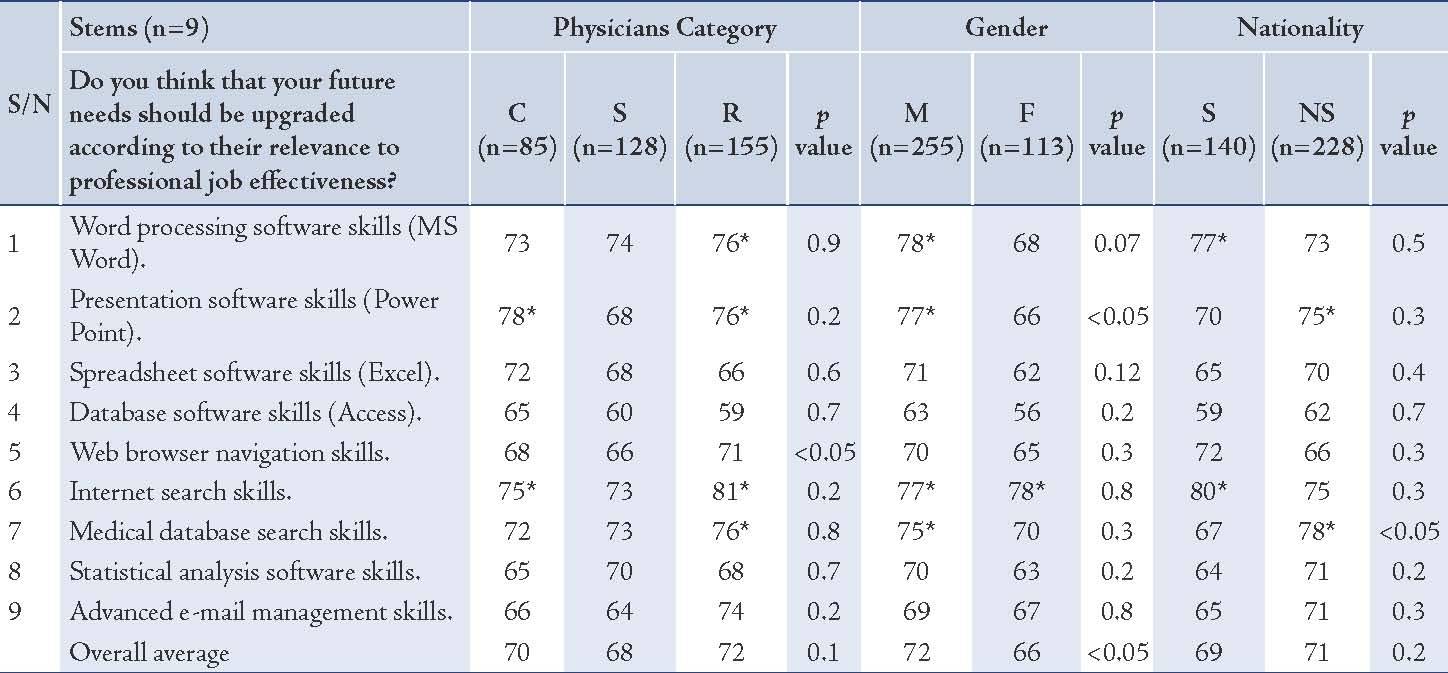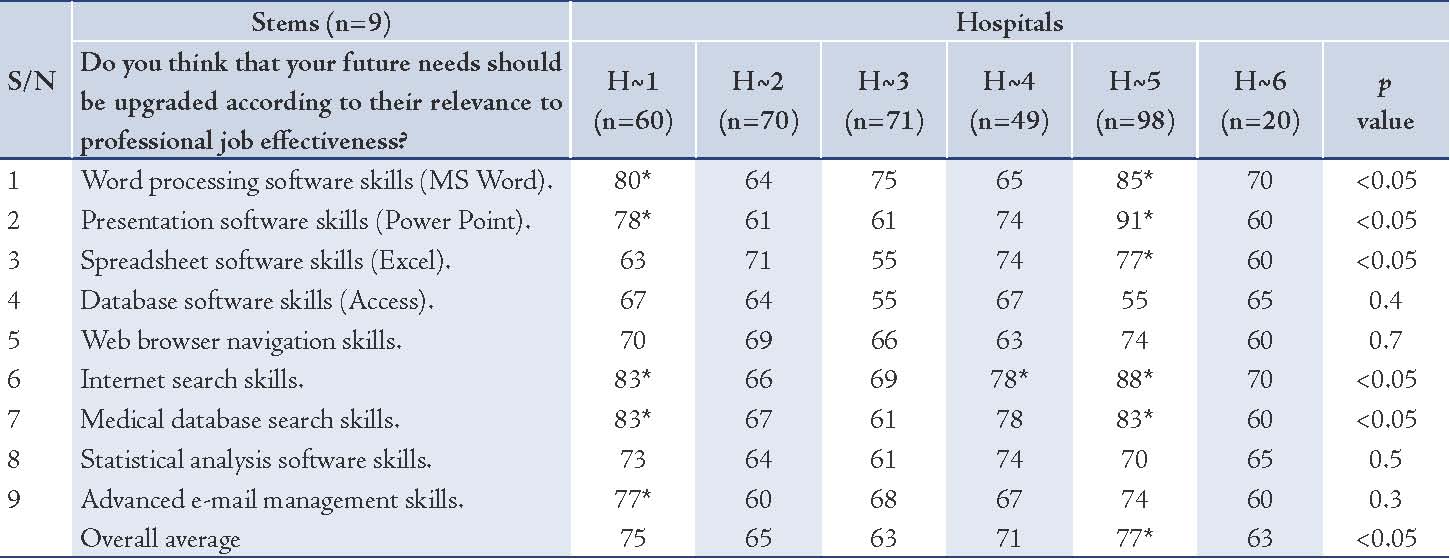|
Abstract
Objective: A confidential inquiry by the Directorate General of health affairs, Makkah region, Saudi Arabia, found physicians were resistant to enter patient-related information in the electronic medical records system at different hospitals. This study aims to highlight their computer literacy needs.
Methods: This cross-sectional survey was conducted on physicians using a structured questionnaire bearing nine questions/stems with dichotomous answers, (i.e., yes/no) that was distributed among physicians at six different Ministry of Health hospitals in the Makkah Region, Saudi Arabia, between May and August 2009. The results for future needs in computer skills were categorized as "none" if the rate of answer "yes" to any stem was 0-25%, "little" if 26-50%, "some" if 51-75% and "substantial" if >75% rated "yes".
Results: The response rate of 82% of determined sample size (n = 451) was attained. Computer literacy improvement elements (CLIE), i.e., "word processing software skills (MS Word)", "presentation software skills (Power Point)", "internet search skills", "medical database search skills", "spreadsheet software skills (Excel)" and "advanced e-mail management skills" were in "substantial" need of improvement among the majority of settings and categories. All other computer literacy improvement elements were in "some" need of improvement.
Conclusion: The overall outcome of this study indicates that physicians need further computer literacy improvements.
Keywords: Computer literacy; Computerized medical record; Cross sectional survey; Electronic medical records system (EMRS).
Introduction
To emphasize physicians to be computer cultured, medical schools developed strategies for teaching medical informatics into the medical curriculum in the USA.1 Information Technology (IT) has encouraging influence on healthcare delivery systems through the development of the computer and its medical applications.2-4 Computer literacy could be affected by factors like: prior knowledge and usage of a computer, personality characteristics, and way of thinking about computers.5
The importance of electronic data entry of patient information is mandatory and increasing rapidly worldwide due to the numerous limitations of keeping data in paper form. The systems which have been used for data entry, i.e., EMRS are also being used to: reduce the rate of medical error, comply with regulatory audits, offer support in medical decision making, promote the use of guidelines, increase coordination between different healthcare providers, and improve the overall quality of healthcare.6,7 To endure all these factors, one of the most important element is computer literacy (CL).
The Directorate general of health affairs (DGHA) in the Makkah region conducted a confidential inquiry and found that physicians were resistant to enter patient-related information into the electronic medical record systems (MERS) at different hospitals. Thus, this survey was conducted to determine the physicians’ CL improvement needs bearing in mind that low CL could be one of the reasons for not computerizing patient data.
Methods
This cross-sectional survey was conducted in the Makkah region, Saudi Arabia, between May and August 2009 at six hospitals governed by the Ministry of Health (MOH) of Saudi Arabia, which have been utilizing the EMR system for the duration of at least one year. King Fahd Hospital in Jeddah (840 bedded), Maternity and Children Hospital in Jeddah (390 bedded), King Abdul Aziz Hospital in Jeddah (559 bedded), King Abdul Aziz Hospital in Taif (691 bedded), Alnoor Specialist Hospital in Makkah (627 bedded), and Hera General Hospital in Makkah (317 bedded) were selected. The study population included all physicians who directly deal with patients working in the allocated settings.
Sample size determination was calculated to be 451 out of a total study population size (i.e., 1802), by keeping the margin of error at 4%, confidence level at 95%, response distribution at 50% and response rate (RR) at 100%. The following formula was applied:
Sample Size = n / [1 + (n/population)]
In which n = Z * Z [P (1-P)/(D*D)]
Where;
N = Sample size; Z = 1.96 with confidence level of 95%; P = response distribution =50% =0.5;
D = margin of error =4% =0.04; Population = 1802
The sample was randomly selected by Neyman’s Pick Proportionate allocation method using a sampling fraction from each of the strata (i.e., hospitals) that is proportional to that of the total population.
A structured questionnaire of one A4 sized paper was prepared. The first portion was designed to obtain information such as gender, nationality (i.e., Saudi or Expatriate), job category (i.e., consultant, specialist, resident), age, (i.e., ≤35, 36-45, 46-55, 56-65 years), and workplace. The second portion encompassed the computer literacy needs, which included nine closed ended questions with dichotomous answers (yes/no). DGHA experts in Medical IT verified the content and face validity of the questionnaire. At each enrolled hospital, a formal demonstration was given in order to explain the details of the project, and the questionnaire was then distribution to the selected subjects. The participants were given three weeks to complete the questionnaires. The results for future needs in computer skills were categorized as "none" if the rate for answers "yes" was 0-25%, "little" if the rate was 26-50%, "some" if the rate was 51-75% and "substantial" if >75% rated "yes".
This study was formally approval by the DGHA, Makkah Region, which was fully briefed about the details of all the potential and future prospects of this research and all respondents were assured that strict confidentiality standards would be exercised.
Statistical analysis was performed using SPSS version 16 (SPSS Inc., Chicago, IL, USA) and the data was subjected to the Chi square test and p-value <0.05 was considered as significant.
Results
A response rate (RR) of 368 (82%) was obtained from the sample size (n=451) with 4.6% margin of error and 95% confidence level, for the total target population of 1802. The study population was predominantly composed of resident physicians (42%), males (69%), expatriates (62%) and participants aged 36-45 years (39%). (Table 1)
Table 1: Demographics of the subjects.

Resident physicians and males were found to have "substantial" needs of CL improvement in the following areas: "word processing software skills (MS Word)", "presentation software skills (Power Point)", "internet search skills", and "medical database search skills". A significant difference was found in terms of gender and the need to improve CL compared with their overall average. (Table 2)
Table 2: The subjects’ computer literacy assessment about anticipated future needs Stratified into Demography.

Table 3: The subjects’ computer literacy assessment about anticipated future need stratified into settings.

Hera General Hospital (Makkah) and Alnoor Specialist hospital (Makkah) were found to substantially need CL improvement, in areas such as "advanced e-mail management skills", and "Spreadsheet software skills (Excel)", respectively, in addition to "word processing software skills (MS Word)", "presentation software skills (Power Point)", "internet search skills", and "medical database search skills", which were common in both hospitals and required "substantial" improvement. All hospitals were found to significantly differ in terms of the needs for improvement in CL compared with their overall average. (Table 3)
Discussion
A background of the value of computer usage in healthcare provision with the basic idea of CL needs formed the basis of conducting the present study. One study that explored physicians’ computer skills in the Kingdom of Saudi Arabia reported average results and found that the physicians were not satisfied with their computer skills. They insisted that developing their computer skills was important towards enhancing treatment and patient care.8
One study in Canada was conducted on pharmacists to rate their anticipated needs for computer skills found that more than 50% of the respondents rated their need for improvement in medical database search and 52% for internet search as "significant". In addition, more than one quarter of the subjects rated their needs to improve web browser navigation (43%), advanced e-mail management (36%), and presentation software skill (35%) as "significant" while 17% expressed that they should be trained on how to use the statistical software and spreadsheet software. The results of this study are to a great extent comparable to the finding of the current study since pharmacists are also healthcare providers, as are physicians.9
In 1996, a survey was conducted on medical students in the USA which revealed that 80% of the respondents needed to learn more about computers during their study period.10 In Sri Lanka, it was reported that almost 40% of pediatricians and residents rated their CL skills as poor and the study recommended the adoption of urgent strategies to correct the situation.11 Another study in India showed that >50% of healthcare professionals were knowledgeable about computers and 22.1% of them had extensive knowledge. However, more than 90% requested further computer training and insisted that it would have a positive impact on their future.12
Similarly in the current study, the survey revealed that physicians generally expressed "some" need for improvement in computer skills except for one hospital that required "substantial" improvement. Literature indicates that the quality of data and its completeness are imperative to the success of any information system. High standard achievements in the EMR system depend upon the end users’ computer literacy and experience. To facilitate the process, it is important to design user friendly EMR systems.13 "Internet search skills" was one of the important CL skills most needed and desired substantially by three hospitals as well as by all hospitals in general. This may also reflect the physicians’ needs to master search engines for clinical literature.
Conclusion
Physicians certainly need some kind of formal introduction and education on computer skills to understand the new medical information technology. The provision of planned computer and information technology training would endow physicians with the skills they need to practice up-to-date and evidence-based medicine in the future, which are vital to improve the quality of medical care. This survey also provides the basis for further studies in order to determine the opinions, attitudes and beliefs of the competency of users of the EMR systems.
Acknowledgements
The authors reported no conflicts of interest and no funding was received for this work.
References
1. Seago BL, Schlesinger JB, Hampton CL. Using a decade of data on medical student computer literacy for strategic planning. J Med Libr Assoc 2002 Apr;90(2):202-209.
2. Myers MR. Telemedicine: an emerging health care technology. Health Care Manag (Frederick) 2003 Jul-Sep;22(3):219-223.
3. Edworthy SM. Telemedicine in developing countries. BMJ 2001 Sep;323(7312):524-525.
4. Feliciani F. Medical care from space: Telemedicine. ESA Bull 2003 May;114:54-59.
5. Cork RD, Detmer WM, Friedman CP. Development and initial validation of an instrument to measure physicians’ use of, knowledge about, and attitudes toward computers. J Am Med Inform Assoc 1998 Mar-Apr;5(2):164-176.
6. Al Farsi M, West DJ Jr. Use of electronic medical records in Oman and physician satisfaction. J Med Syst 2006 Feb;30(1):17-22.
7. Al-Mujaini A, Al-Farsi Y, Al-Maniri A, Ganesh A. Satisfaction and perceived quality of an electronic medical record system in a tertiary hospital in oman. Oman Med J 2011 Sep;26(5):324-328.
8. Mansoor I. Computer skills among medical learners: a survey at King Abdul Aziz University, Jeddah. J Ayub Med Coll Abbottabad 2002 Jul-Sep;14(3):13-15.
9. Balen RM, Jewesson PJ. Pharmacist computer skills and needs assessment survey. J Med Internet Res 2004 Mar;6(1):e11.
10. Hollander S. Assessing and enhancing medical students’ computer skills: a two-year experience. Bull Med Libr Assoc 1999 Jan;87(1):67-73.
11. Senanayake MP. Computer usage by paediatricians in Sri Lanka. Sri Lanka J Child Health 2006;35:83-85.
12. Gour N, Srivastava D. Knowledge of computer among healthcare professionals of India: a key toward e-health. Telemed J E Health 2010 Nov;16(9):957-962.
13. Fraser HS, Biondich P, Moodley D, Choi S, Mamlin BW, Szolovits P. Implementing electronic medical record systems in developing countries. Inform Prim Care 2005;13(2):83-95.
|